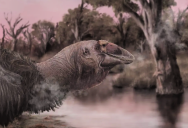Scientists Discover An Intact Skull Of Yet Another Terrifyingly Large Australian Animal, The Giga-Goose

There is a pretty common joke that every animal that exists in Australia is trying to kill you.
I don’t know whether this ancient, giant fowl would have gone after human beings if they had crossed path, but that doesn’t make it any less terrifying.
And that’s just based on images of an intact skull.
The huge bird is Genyornis newtoni, and is one of the last giant thunder birds that once proliferated in Australia.
The category Dromornithidae (also known as mihirungs or thunder birds), contains Dromornis stirtoni, which is thought to be the largest bird that ever lived.

The majority of these birds were extinct long before humans inhabited Australia, and the last one – G. newtoni – soon followed suit.
Experts posit this had something to do with human beings, like hunting, egg consumption, or fires.
Though only half the weight of its heaviest ancestors, this bird was still objectively massive. Although we have known of its existence for 128 years, but this is the first time an intact skull has been found.
Fossils have been found at Lake Callabonna, but numerous issues have made excavating in the area challenging, says study co-author Jacob Blokland.
“It’s on private land, very hard to get to and has sandstorms. To make things worse, the site is now a salt lake, and as soon as fossils removed from it dry out the salt starts breaking them up.”

Dr. Trevor Worthy decided to figure out to tackle these challenges, though, and organized a series of visits.
What they have pieced together is a bird that could walk well but that lived largely in the water, resembling many modern-day waterfowl.
“It walked long distances between ephemeral wetlands. We imagine it was an ecosystem engineer, crashing around in the reeds and uprooting things.”
They call it’s braincase “massive,” but first author Phoebe McInerney clarifies this doesn’t necessarily mean it was smart.
“Their brains were smaller than you would expect. Normally the braincase is very close to the brain. Brains are very energy and nutrient-hungry. If you don’t need more brain, then its more energy-efficient to fill the space up with bone.”
Their large skulls were a function of needing support for a large beak, ones designed to eat fruit. McInerney posits that the bird could have been responsible for the spread of a certain fruit-bearing tree in the region – one that no surviving species other than humans can distribute.

The beak and jaw were very interesting to the researchers.
“Genyornis newtoni had a tall and mobile upper jaw like that of a parrot but shaped like a goose, a wide gape, strong bite force, and the ability to crush soft plants and fruit on the roof of their mouth.”
“The term goose can cover quite a wide range – it really just means a long-legged waterfowl that has become a bit more terrestrial.”
This goose weighed fifty times its modern counterpart, though, and has thus been dubbed a “gigagoose.”
Seems appropriate.
As if regular-sized geese aren’t terrifying enough.
Thought that was fascinating? Here’s another story you might like: Why You’ll Never See A Great White Shark In An Aquarium

Sign up to get our BEST stories of the week straight to your inbox.




